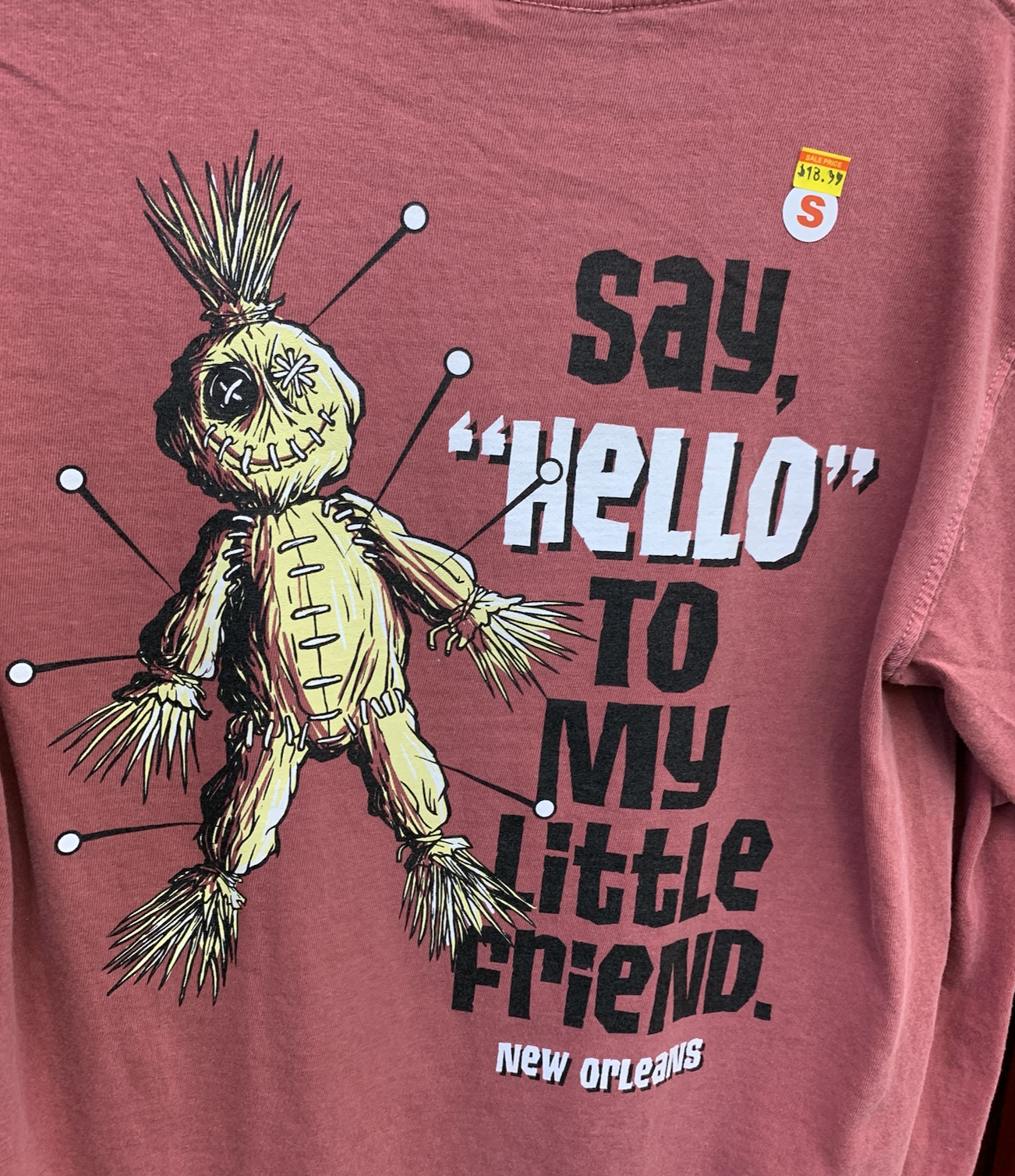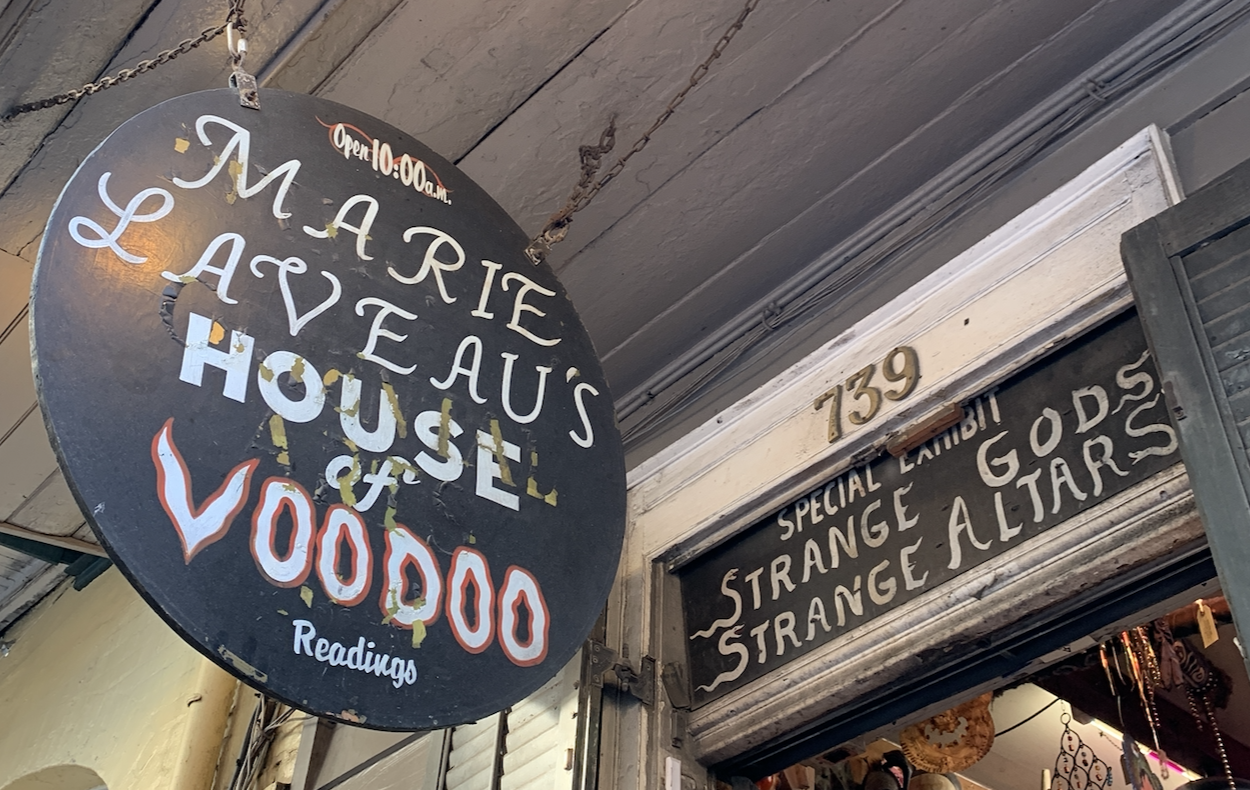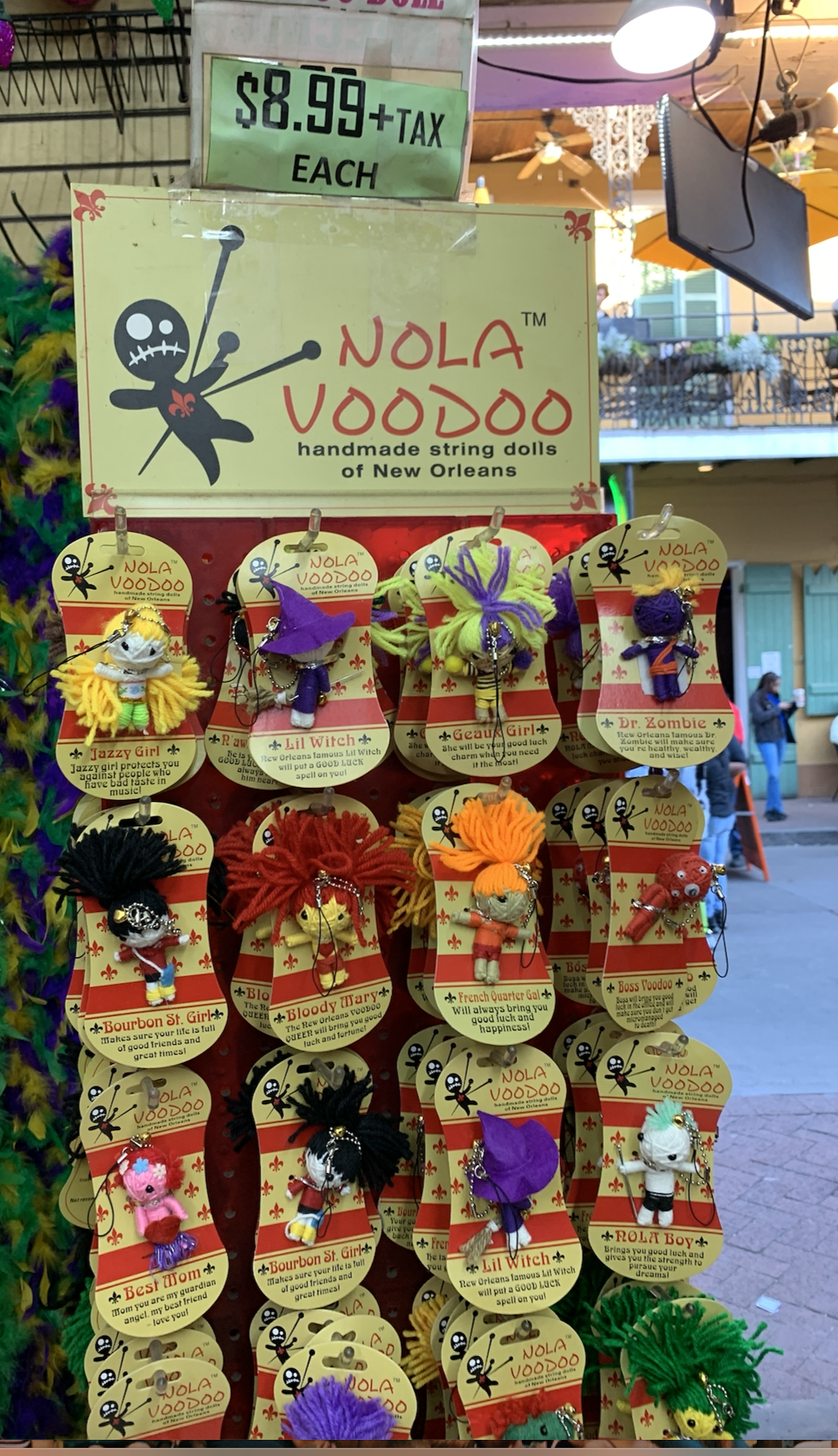
T-shirt pictured at Big Easy Gifts gift shop in the French Quarter. (Pictured by Annalise Rotunda)
Blood pouring out of a sheep’s neck and hexing those that cross you during a full moon; Voodoo is pretty scary, is it not? Short Answer: It is not. Especially to Voodoo priests, priestesses, and Hoodoo practitioners—known as rootworkers—who regard Voodoo as a sacred religion and understand its earth-based roots and extensive history. Yvonne Chireau, Professor of Religion at Swarthmore College, writes, “In the era of slavery, questions of security loomed large in African American experience… for its part, Conjure spoke directly to the slaves’ perceptions of powerlessness and danger by providing alternatives—but largely symbolic—means for addressing suffering. The Conjuring tradition allowed practitioners to defend themselves from harm, to cure their ailments, and to achieve some conceptual measure of control over personal adversity.” Yet, the Voodoo Authentica Cultural Center and Collection in the French Quarter of New Orleans is owned by a white man from Idaho.
NewOrleans.com encourages people to find their narrative on the streets of New Orleans by stating, “In a city with no last call, there’s always a place to celebrate.” The celebrations that beckon the over 18.5 million people to visit the French Quarter annually (throughout Bourbon St., Royal St., and the entire French Quarter) will introduce visitors to the idea of Voodoo. The Voodoo Lounge sits on Rampart and advertises itself as a dive bar to “wind down at after a night in the quarter,” while the gift shop Voodoo Blues boasts a tagline of “may the curse be with you!” Even if they were listening to this introduction, the most common sentiment that they might hear is that of the occult treatment of the Voodoo culture, rather than its devout and divine auspices that pioneers like Marie Laveau were attempting to communicate through the religion.
Quickly after hopping on Bourbon, the word “Voodoo” will soon meet the eyes of any average tourist. Eventually, one might stumble upon a place like Marie Laveau’s House of Voodoo, where tourists can leave their drinks to gather a few “lucky” gifts. Posted next to the door is the Acknowledgement of Registration from the governor to open safely; the “Building Use” is classified as a “Retail Shop”. Above the door, a sign reads “Strange Gods Strange Altars,” an interesting adjective to describe the contents of the supposed home of Marie Laveau. Strange is defined as “weird,” “unfamiliar” or “not belonging to the place where it was found.” The sign holds a great deal of ethnocentrism and is ironic in the use of the adjective calling a “House of Voodoo” strange, while New Orleans’ Voodoo Spiritual Temple, a religious place of worship, lies less than a mile away. Wicca charms and Celtic vision charms, both products unrelated to Voodoo, are sold next to $297 supposedly legitimate Voodoo “ancestor figures”. Lacking in the building—which adamantly insists to avoid pictures—is anything but even a brief introduction to Voodoo. Among rows of occult instruments and figures and a large wall of “Marie Laveau’s House of Voodoo” t-shirts, sweatshirts and tank tops, these types of shops don’t even try to hide their use of culture and religion for strictly profitable ends.

The sign hanging directly above the entrance of Marie Laveau’s House of Voodoo on Bourbon Street in the French Quarter. (Photo by Annalise Rotunda)
One t-shirt from Bourbon Gifts depicts a skeleton with “Bone to Get Busy Voodoo Style” written across the front, and another has a Voodoo doll with a pin and “Pin & Needles. Hoodoo. Voodoo. We do. Mojo to go” splashed across its cotton. Both t-shirts have “New Orleans” and “French Quarter” in large, bolded letters on the outside of their illustrations. Both Bourbon Gifts and Tricou Gifts, along with many other gift shops throughout the quarter, have a tall cart of “NOLA Voodoo handmade string dolls” filled with over twenty different types of characters to choose from. “Diet Voodoo” will “bring you good luck so you can lose the extra pounds and get fit!” and “Bourbon Street Girl” is a character who “makes sure your life is full of good friends and great times!” The “Love Pirate” should be carried to help you “capture the one you desire. Arrrrrr!” and the “Dr. Zombie” doll, possibly made to depict the famous Voodoo figure Dr. John, “will make sure you’re healthy, wealthy, and wise!” On the NOLA Voodoo string dolls website, they state their dolls are “handmade in China” and like to call them “$10 pieces of art.” There is not a single signature or statement from a Voodoo priest, priestess, or practitioner stating they blessed these dolls.
Marie Laveau’s House of Voodoo and Reverend Zombie’s House of Voodoo are undoubtedly filled with a menagerie of random occult and religious trinkets and struggle to provide much exploration into the history of Voodoo. The stores lack historical and educational elements, and there is debatable sanctity in much, except the shrines to Marie Laveau and other Voodoo priests and priestesses seen in both. Marie Laveau’s House of Voodoo showcases its commercialization of the sacred religion by placing one of the shrines to Marie Laveau next to a very large wall of t-shirts to commemorate anyone’s visit.

NOLA Voodoo string dolls pictured at Tricou Gifts on Bourbon Street. (Pictured by Annalise Rotunda)
A turn onto Dumaine will also take tourists into Voodoo Authentica, where the sign labels the store as a “Cultural Center & Collection.” Inside, once again, is a haul of dolls, candles and potions in the presence of occult and spiritual goods that serve no use in the proclaimed “Cultural Center & Collection.” Here as well, far more price tags lined the walls than anything to do with being a spiritual or cultural center. Selling and buying Voodoo is seemingly the new way of practicing under these impressions. The United Nations Educational, Scientific, and Cultural Organization describes the content of a cultural center as having a “structure… based on broad spaces where different cultural manifestations enrich and liven up the cultural life of the local population.” While the former two stores may have been more honest in their fate as mere tourist traps, this one’s sign guides visitors to believe they will be thoroughly learning about the religion and its impact on New Orleans.
Bourbon Gifts, Tricou Gifts, Big Easy Gifts, Gator Country Gift Shop, and The Royal Gifts are all tourist shops in the French Quarter. When asking checkout clerks from multiple gift shops if they donated any portion of the money made of Voodoo-related items to the Voodoo Spiritual Temple on Rampart or any local practitioners, the question was met with confusion, annoyance, and multiple “no”s.
For full transparency, I am a white female writing on the appropriation of a subject who’s history I will not even begin to summarize, as it must be respected through effort, time, and investigation. I am constantly learning more about the world’s many cultural practices and am by no means an expert on the religion or subject of Voodoo. The ideas presented in this article are not aimed to be malicious towards anybody in or related to the Voodoo community.
 NOLAbeings Multimedia artist Claire Bangser created NOLAbeings as a portrait-based story project that marries...
NOLAbeings Multimedia artist Claire Bangser created NOLAbeings as a portrait-based story project that marries...  Voodoo in New Orleans: Reviving history: New Orleans fortune telling This article takes a deep dive into the history of Voodoo in New Orleans, its hybridization with Catholicism, and its present-day place in the city's culture. The author visits fortune-tellers in the French Quarter, using their guidance as a tool for introspection rather than a deterministic predictor of the future. Through her experiences in New Orleans, the author feels a mystical connection to both the past and the future.
Voodoo in New Orleans: Reviving history: New Orleans fortune telling This article takes a deep dive into the history of Voodoo in New Orleans, its hybridization with Catholicism, and its present-day place in the city's culture. The author visits fortune-tellers in the French Quarter, using their guidance as a tool for introspection rather than a deterministic predictor of the future. Through her experiences in New Orleans, the author feels a mystical connection to both the past and the future. 